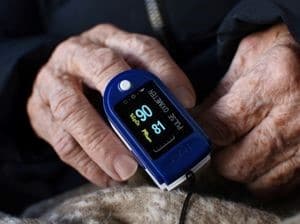
A person with low blood oxygen levels, or hypoxemia, can experience symptoms like headaches, a rapid heart rate, and difficulty breathing. Read on to discover what caregivers should know about low blood oxygen levels so you can provide the best home care for your clients.
Causes of Hypoxemia
Blood carries oxygen from the lungs to the tissues throughout the body. Cells in the tissues use oxygen to unlock energy. When someone has low blood oxygen levels, their body may not function properly.
Certain medications can also cause hypoxemia, but the most common cause is an underlying illness that affects breathing or blood flow, like heart and lung conditions. Your client might have hypoxemia if they can’t inhale enough oxygen or if the oxygen isn’t getting into the bloodstream.
Some people have periodic hypoxemia. Sleep apnea is a disorder in which breathing starts and stops, and it can cause hypoxemia during sleep. You can improve your client’s quality of life and boost their energy by thoroughly understanding sleep disorders in the elderly.
Symptoms and Diagnosis
Caregivers should know the symptoms of low blood oxygen levels. If you notice any signs of hypoxemia, call a healthcare provider or bring your client to the nearest emergency room. Seek medical attention immediately for fast treatment that can prevent organ damage in severe cases. Symptoms of low blood oxygen levels include:
- Headache
- Shortness of breath
- Coughing
- Wheezing
- Fast heartbeat
- Confusion
- Bluish skin, fingernails, or lips
The physician will listen to the patient’s heart and lung function. They can use a pulse oximetry monitor to non-invasively measure the amount of oxygen in the blood. Or they might conduct an arterial blood gas test on a blood sample taken from the patient’s wrist, groin, or arm.
Treatment
Treatment regimens focus on the underlying causes of hypoxemia. The doctor might prescribe an inhaler for people with lung disease, and a CPAP machine can treat sleep apnea.
For a patient with an ongoing risk of hypoxemia, the doctor might prescribe supplemental oxygen. Your client might need to use portable oxygen at their home or in the hospital. You and your client can continue monitoring blood oxygen levels at home with a pulse oximetry monitor.